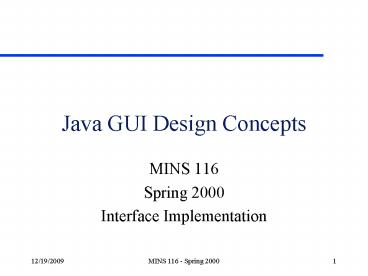Java GUI Design Concepts - PowerPoint PPT Presentation
1 / 22
Title:
Java GUI Design Concepts
Description:
MINS 116 - Spring 2000. 3. From Salvo to Implementation ... MINS 116 - Spring 2000. 10. Java GUI Components. Components are placed in a frame. ... – PowerPoint PPT presentation
Number of Views:443
Avg rating:3.0/5.0
Title: Java GUI Design Concepts
1
Java GUI Design Concepts
- MINS 116
- Spring 2000
- Interface Implementation
2
Topics
- Logical system architecture
- Java GUI elements ( Swing Set )
- Layout Managers
- Events
3
From Salvo to Implementation
- SALVO gives us a method to use for specification
of GUI look and feel. - The next step is to use Java it implement this
front end.
4
Remember the architectural layers...
- Architectural models
- 2-Tier -
Business logic must be embedded in the UI.
Changes to the UI effect the business logic and
vice-versa.
5
Remember the architectural layers...
- Architectural models
- 3-Tier -
Business logic is contained in a layer of
code logically detached from the underlying
business information. The two can evolve
independently.
6
Remember the architectural layers...
- Architectural models
- N-Tier -
Introduction of networks and information
distribution introduces more layers of
abstraction to effectively manage changes to the
distributed nature of the business processes.
7
Our current target -
- Our current target in dealing with is the UI
portion of the Tiered Architecture. - In this class, we will only create programs for a
3-Tiered architectural model.
8
Java GUI Components
- JLabel - An area where uneditable text or icons
can be displayed. - JTextField - A area in which the user inputs data
from the keyboard. The area can also display
information. - JButton - An area triggering an event when
clicked. - JCheckBox - A box either selected or not.
- JComboBox - A drop-down list of items from which
the user can make a selection. - JList - An area where a list of items is
displayed from which the user can make a
selection. - JPanel - A GUI container in which GUI components
can be placed.
9
Java GUI Components
- A quick example
10
Java GUI Components
- Components are placed in a frame.
- The frame makes up the container for the
components and defines the boundaries of the
components which make up the GUI. - A Frame can also contain Panels which logically
group components. - Frames/Panels work in concert with a Layout
Manager to control how GUI components are
arranged on the GUI screen.
11
Layout Managers
- WSISYG GUI builders usually rely on layout
managers that are proprietary to the IDE you are
using. - What do you think happens when you deploy a Java
applet in an environment which does not support
the layout manager you designed your applet in?
12
Layout Managers
- The three layout managers we will consider are
- Flow Layout
- Border Layout
- Grid Layout
13
Flow Layout
- In the Flow Layout manager, GUI components are
placed on a container (e.g. a JFrame) from left
to right in the order in which they are added to
the container.
See FlowLayout in the Java documentation.
14
Border Layout
- In the Border Layout manager, GUI components are
arranged in five regions - North
- South
- East
- West
- Center
15
Border Layout
See BorderLayout in the Java documentation.
16
Grid Layout
- The Grid Layout divides the Java container into a
defined grid.
See GridLayout in the Java documentation.
17
A Java Example
- public class FrameDemo extends JFrame // Demo
extending JFrame - private FlowLayout layout // Layout Manager
- private Container c // Layout
Container - private JButton left // A
button to add to the container - public FrameDemo( ) // Constructor
- layout new FlowLayout( ) // Create a
layout manager - c getContentPane( ) // Get the container
getContentPane is a method of JFrame - c.setLayout( layout ) // Assign the
layout manager to the container for this JFrame - left new JButton( Left) // Create the
new button - c.add( left ) // Add the button to the
container - layout will control how this button
is - // placed on the screen.
18
From GUI components to events
- Up to this point, we have seen how to create a
layout manager, assign it to a GUI frame, then
create and add GUI components to the frame. The
physical location of these components is then
controlled by the layout manager we have created. - Referring back to our 3-tier model, we need a way
to get user desires into the underlying logic
which will perform actions on the users behalf.
This logic resides in the Business Layer.
19
Events
- Events will provide our programs with
- A nice mechanism to keep our business logic
de-coupled from our GUI. - The ability to receive commands from the GUI we
have built. - A structured framework in which to handle GUI
behavior.
20
Event Creation and Assignment
- Event handlers are assigned to components.
21
Events.
- Standard events are set up to handle
- Key Stroke Events - Happens when the user types
on the keyboard. - Mouse Events - Happens associated with different
uses of the mouse. - Window Events - Window opening, closing, hide,
etc. - Paint Events - Screen refresh, etc.
- Focus Events - Action focus set to a component.
22
Summary
- SALVO helps with GUI design, Java has several
components to help realize that design. - The use of a 3-Tier architecture will be employed
in our projects. - The Java event model helps enforce the
de-coupling of the GUIs we are building from the
underlying business logic.

